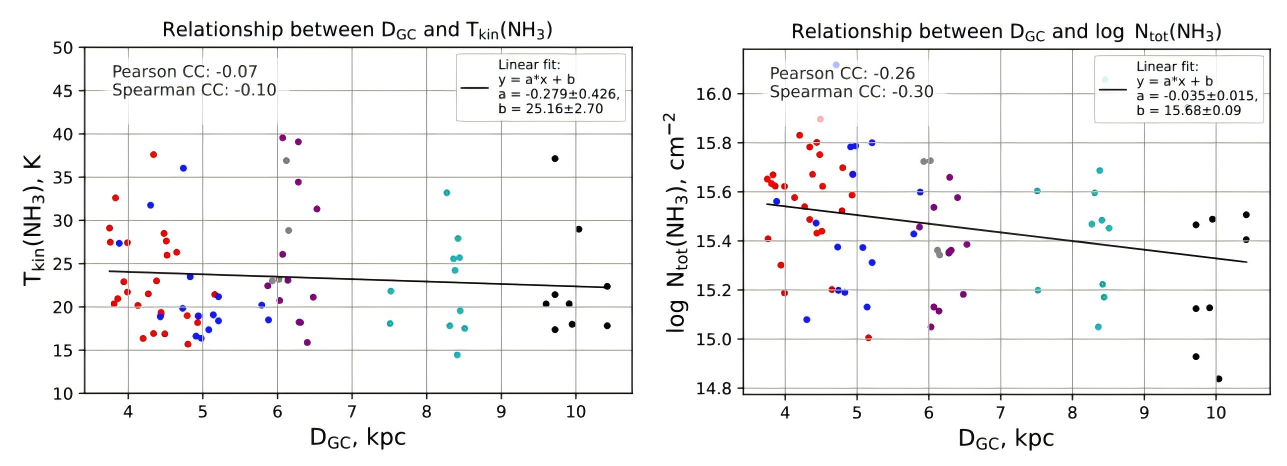
Researchers led by Ph.D student Serikbek Sailanbek from the Xinjiang Astronomical Observatory of the Chinese Academy of Sciences has conducted a comprehensive analysis of dense star-forming clumps across the Milky Way.
The results were published in the Monthly Notices of the Royal Astronomical Society.
Using ammonia (NH₃) data obtained from the NanShan 26-m Radio Telescope (NSRT), the researchers selected 217 dense clumps from the Bolocam Galactic Plane Survey (BGPS v1.0) catalog. These clumps were chosen based on a 1.1 mm flux threshold greater than 5 Jy and were observable from NSRT. And they performed NH3(1,1) and (2,2) inversion transitions survey.
A remarkable detection rate of 86.6% was achieved, with 188 sources showing clear ammonia emission. These sources span a broad range of galactic longitudes (1.2°to 192.6°), covering major spiral arms—including the Perseus, Sagittarius-Carina, Scutum-Centaurus, and Norma arms, at distances between 0.16 to 17.23 kiloparsecs. The ammonia emission lines reveal linewidths of 0.91–6.98 km/s and rotational temperatures between 9.7 and 50.2 K, indicating a dynamic range of physical conditions.
A key finding is the positive correlation between turbulence and temperature, suggesting that stellar feedback influences the internal dynamics of these clumps. In contrast, several clumps with broad lines and low temperatures may represent early, prestellar phases. The study also highlights the strong correlation between gas and dust temperatures, validating temperature estimation methods used in molecular clouds studies, especially in high-temperature regions.
Widespread star formation activity was observed, with three notable results: first. 82% of the sources are associated with 22 GHz water masers, a hallmark of active star formation; Second, 52% qualify as High-Mass Star-Forming Regions (HMSFRs), identified through detections of 6.7 GHz class II methanol masers; Third, 3. Among these HMSFRs, 72% exhibit indicators of late evolutionary stages, such as the presence of OH or 12 GHz methanol masers.
Through statistical analysis, the researchers demonstrated that maser detected sources have significantly higher kinetic temperatures and ammonia column densities with results reaching 3σ statistical significance. This reinforces the diagnostic value of maser detection in identifying active and evolving star-forming regions.
Furthermore, the study reveals a weak negative correlation between ammonia column density and Galactocentric distance within the 2–8 kpc range. This may reflect broader Galactic chemical or density gradients, although local conditions—such as turbulence and spiral arm features—appear to exert a stronger influence on regional variations.
This study significantly advances our understanding of the physical conditions and star formation activities within the Galaxy, and lays a foundation for future investigations of Galactic structure and the role of masers in tracing star formation.

Face-on view of the Milky Way (from the north Galactic pole) showing the distribution of ammonia-observed sources matched with the Hi-GAL 360 catalog. Spiral arms are adapted from Reid et al. (2019). Marker sizes reflect ammonia column densities; arm associations are indicated by color. Red dashed circles mark the 2–8 kpc distance-limited sample. (Image by Serikbek Sailanbek)

Face-on view of the Milky Way (from the north Galactic pole) showing the distribution of ammonia-observed sources matched with the Hi-GAL 360 catalog. Spiral arms are adapted from Reid et al. (2019). Marker sizes reflect ammonia column densities; arm associations are indicated by color. Red dashed circles mark the 2–8 kpc distance-limited sample.Correlations between Galactocentric distance and ammonia properties for sources within 2–8 kpc: (left) log of total NH₃ column density, (rigth) gas kinetic temperature. Points are colored by spiral arm association. Best-fit lines and correlation coefficients are indicated in each panel. (Image by Serikbek Sailanbek)

86-10-68597521 (day)
86-10-68597289 (night)

52 Sanlihe Rd., Xicheng District,
Beijing, China (100864)

